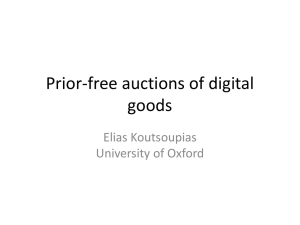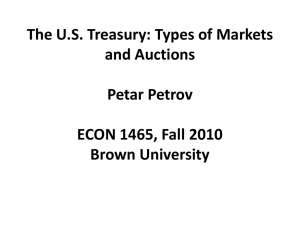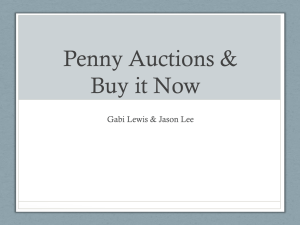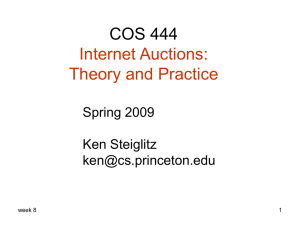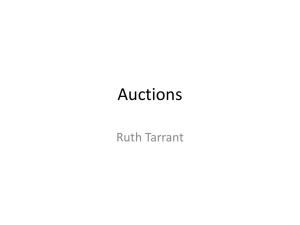Network Economics -- Lecture 2: Pricing of
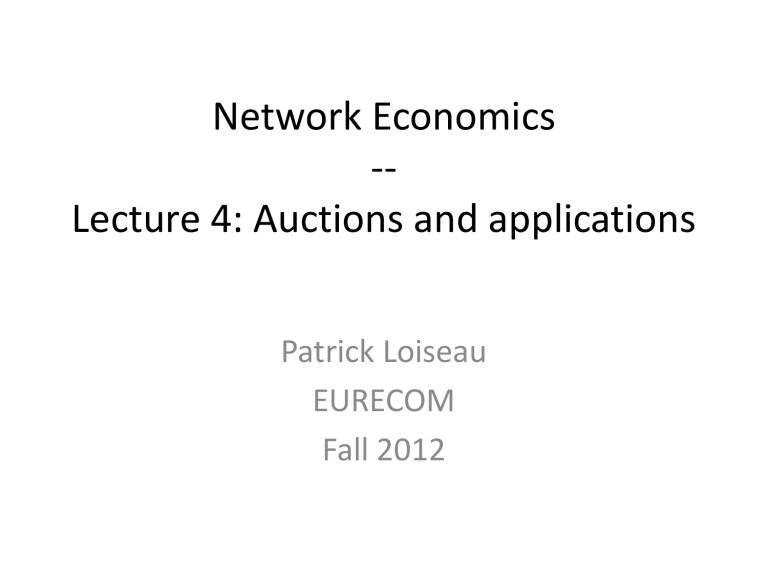
Network Economics
--
Lecture 4: Auctions and applications
Patrick Loiseau
EURECOM
Fall 2012
References
• V. Krishna, “Auction Theory”, Elseiver AP 2009 (second edition)
– Chapters 2, 3, 5
• P. Milgrom, “Putting auction theory to work”, CUP 2004
– Chapter 1
• D. Easley and J. Kleinberg, “Networks, Crowds and
Markets”, CUP 2010
– Chapters 9 and 15
• Ben Polak’s online course http://oyc.yale.edu/economics/econ-159
– Lecture 24
Outline
1. Generalities on auctions
2. Private value auctions
3. Common value auctions: the winner’s curse
4. Mechanism design
5. Generalized second price auction
Outline
1. Generalities on auctions
2. Private value auctions
3. Common value auctions: the winner’s curse
4. Mechanism design
5. Generalized second price auction
Where are auctions?
• Everywhere!
– Ebay
– Google search auctions
– Spectrum auctions
– Art auctions
– Etc.
What is an auction?
• Seller sells one item of good through bidding
– Set of buyers
• Buyer buys one item of good
– Set of sellers
– Called procurement auction (governments)
• Auctions are useful when the valuation of bidders is unknown
• More complex auctions
– Multi-items
– Combinatorial
Standard auction
• Standard auction: the bidder with the highest bid wins
• Example of nonstandard auction: lottery
The two extreme settings
• Common values Private values
Main types of auctions
1. Ascending open auction (English)
2. Descending open auction (Dutch)
3. First-price sealed bid auction
4. Second price sealed bid auction (Vickrey)
Relationships between the different types of auctions
Outline
1. Generalities on auctions
2. Private value auctions
3. Common value auctions: the winner’s curse
4. Mechanism design
5. Generalized second price auction
Private value auctions: Model
• One object for sale
• N buyers
• Valuation X
• X i i
’s i.i.d. distributed on [0, w], cdf F(.)
• Bidder i knows
– Realization x i of his value
– That other bidders have values distributed according to F
• Def: symmetric: all bidders have the same distribution of value
Game
• The game is determine by the auction rules
– Game between the bidders
• Bidder’s strategy: β i
: [0, w] [0, ∞)
• Look for symmetric equilibria
– 1 st price auction
– 2 nd price auction
– Compare seller’s revenue
Second-price sealed-bid auction
• Proposition: In a second-price sealed-bid auction, bidding its true value is weakly dominant
First-price sealed-bid auction
• Bidding truthfully is weakly dominated
First-price sealed-bid auction (2)
• What is the equilibrium strategy?
First-price sealed-bid auction (3)
• Proposition: Symmetric equilibrium strategies in a first-price sealed-bid auction are given by b
( x )
= [
1
| Y
1
< x
] where Y
1 is the maximum of N-1 independent copies of X i
Example
• Values uniformly distributed on [0, 1]
Revenue comparison
• With independently and identically distributed private values, the expected revenue in a firstprice and in a second-price auction are the same
Proof
Warning
• This is not true for each realization
• Example: 2 bidders, uniform values in [0, 1]
Revenue equivalence theorem
• Generalization of the previous result
• Theorem: Suppose that values are independently and identically distributed and all bidders are risk neutral. Then any symmetric and increasing equilibrium of any standard auction such that the expected payment of a bidder with value zero is zero yields the same expected revenue to the seller.
• See an even more general result in the (beautiful) paper R.
Myerson, “Optimal Auction Design”, Mathematics of
Operation Research 1981
– 2007 Nobel Prize
Proof
Reserve price
• r>0, such that the seller does not sell at a lower price
Reserve price in second-price auction
• No bidder with value x<r can make a positive profit
• Bidding truthfully is still weakly dominant
• Winner pays r if the determined price is lower
• Expected payment
Reserve price in first-price auction
• No bidder with value x<r can make a positive profit
• Symmetric equilibrium:
• Expected payment:
Effect of reserve price on revenue
• Seller has valuation x
0
• Sets r>x
0
! of the good
• Optimal reserve price:
• Increases the seller’s revenue
– Sometimes called exclusion principle
Remark
• Efficiency: maximize social welfare
– Good ends up in the end of the highest value among bidders and seller
• Efficient is NOT the same as revenue optimality
• Example
– Seller with valuation zero
Outline
1. Generalities on auctions
2. Private value auctions
3. Common value auctions: the winner’s curse
4. Mechanism design
5. Generalized second price auction
The winner’s curse
• Good has value V, same for all bidders
– Example: oil field
• Each bidder has an i.i.d. estimate x i
=V+e i the value (E(e i
)=0)
• They all bid (e.g., first-price auction) of
The winner’s curse (2)
• Suppose bidder 1 wins
• Upon winning, he finds out his estimate was too large! bad news: winner’s curse
• Bid as if you know you win!
• Remark: the winner’s curse does not arise at equilibrium, if your bid takes it into account.
Outline
1. Generalities on auctions
2. Private value auctions
3. Common value auctions: the winner’s curse
4. Mechanism design
5. Generalized second price auction
Mechanism design
• An auction is only one of many ways to sell a good
• Mechanism design studies the design of rules such that the resulting game yields a desired outcome
• The 2007 Nobel Memorial Prize in Economic
Sciences was awarded to Leonid Hurwicz, Eric
Maskin, and Roger Myerson "for having laid the foundations of mechanism design theory"
• Buyers
• Values
• Set of values
• Distributions
• Product set
• Joint density
Setting
Mechanisms
• Set of messages (bids)
• Allocation rule
• Payment rule
• Example: 1 st or 2 nd price auction
• Definition
Direct mechanism
• Characterization: Pair (Q, M)
• Truthful equilibrium
Revelation principle
• Given a mechanism and an equilibrium for that mechanism, there exists a direct mechanism such that
1. It is an equilibrium for each buyer to report his value truthfully
2. The outcomes (probabilities Q and expected payment M) are the same as in the equilibrium of the original mechanism
Proof
Incentive compatibility (IC)
• A direct revelation mechanism is IC if it is optimal for a buyer to report his value truthfully when all other buyers report their value truthfully
Revenue equivalence
• If the direct mechanism (Q, M) is incentive compatible, then the expected payment is m i
( x i
)
= m i
(0)
+ q i
( x i
) x i
ò
0 x i q i
( t i
) dt i
• Thus, the expected payment in any two incentive compatible mechanisms with the same allocation rule are equivalent up to a constant
• Generalizes the previous version
Two questions
• How to design a revenue optimal mechanism?
• How to design an efficient mechanism?
• Restricting to
– IC mechanisms
– Individually rational mechanisms (i.e., such that the expected payoff of every buyer is nonnegative)
Optimal mechanism
• Define the virtual valuation y i
( x i
)
= x i
-
1
-
F i f i
( x i
( x i
)
)
• Define y i
( x
i
)
= inf
{ z i
: y i
( z i
)
³
0 and y i
( z i
)
³ y j
( x j
) for all j
}
• Under some regularity conditions, the optimal mechanism is: allocate to the buyer with highest virtual valuation (if it is nonnegative), with expected payment y i
(x
-i
)
Symmetric case
• We find the second price auction with reserve price y -
1 (0)
Efficient mechanism
• Social welfare maximized by Q *
• If there is no tie: allocation to the buyer with highest value
• Notation:
VCG mechanism: definition
• The VCG mechanism is (Q * , M V ), where
M i
V
( x )
=
W (0, x
i
)
-
W
i
( x )
• Note: the W’s are computed with the efficient allocation rule
VCG mechanism: properties
• The VCG mechanism is
– Incentive compatible – truthful reporting is weakly dominant
– Individually rational
– Efficient
• i’s equilibrium payoff is the different in social welfare induced by his truthful reporting instead of 0
• Proposition: Among all mechanisms for allocating a single good that are efficient, IC and IR, the VCG mechanism maximizes the expected payment of each agent
Example
• In the context of auctions: VCG = 2 nd price auction!
Outline
1. Generalities on auctions
2. Private value auctions
3. Common value auctions: the winner’s curse
4. Mechanism design
5. Generalized second price auction
Sponsored search
• Ads in sponsored box
• Several spots: multiple items auction
• Pay per click for the advertiser
Generalized second price auction
(GSP)
• How Google determines which ad is shown for a given keyword?
• Advertisers submit bids
• Google ranks ads by bid x expected nb of clicks
– Ad quality factor
• Advertisers pay the price determined by the bid below (GSP)
GSP properties
• GSP is not truthful
• GSP is not VCG
• GSP may have several equilibria
• GSP’s revenue may be higher or lower than VCG’s revenue
• B. Edelman, M. Ostrovsky, M. Schwarz, “Internet
Advertising and the Generalized Second-Price Auction:
Selling Billions of Dollars Worth of Keywords”, American
Economic Review 2007
• H. Varian, “Position auctions”, International Journal of
Industrial Organization 2007



